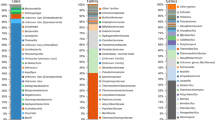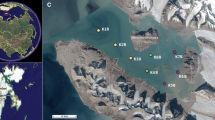Abstract
Culturable bacteria from the deep subsurface (179 m) at Cerro Negro, New Mexico were isolated and characterized. The average number of viable aerobic bacteria was estimated to be 5×105g−1 of sediment, but only about 0.1% of these could be recovered on agar medium when incubated under aerobic conditions. Of 158 strains isolated from this depth, 92 were characterized by cellular fatty acid profiles (FAME), 36 by analysis of partial 16S rDNA sequences, and 44 by rep-PCR genome fingerprint analysis using three different sets of oligonucleotide primers (REP, BOX, or ERIC). These analyses showed the majority of isolates (67%) were Gram-positive bacteria and primarily members of genera with a high %G+C DNA. The remaining isolates were α-subdivisionProteobacteria (19%) and members of the flavobacteria group (14%). The diversity indices based on these different methods of characterization were very high suggesting this subsurface habitat harbors a highly diverse microbial community.
Similar content being viewed by others
References
Altschul SF, W Gish, W Miller, EW Myers and DJ Lipman. 1990. Basic local alignment search tool. J Mol Biol 215: 403–410.
Amy PS, DL Haldeman, D Rigelberg, DH Hall and C Russel. 1992. Comparison of identification systems for classification of bacteria isolated from water and endolithic habitats within the deep subsurface. Appl Environ Microbiol 58: 3367–3373.
Atlas RM. 1984. Diversity of microbial communities. In: Advances in Microbial Ecology. Vol 7 (Marshall KC ed) pp 1–147, Plenum Press, NY, London.
Atlas R and R Bartha. 1987. Microbial Ecology: Fundamentals and Applications. 2nd edn, pp 61–98, The Benjamin/Cummings Publishing Co, Menlo Park, Reading.
Baars DL, BL Bartleson, CE Chapin, BF Curtis, RH DeVoto, JR Everett, RC Johnson, CM Molenaar, F Peterson, CJ Schenk, JD Love, IS Merin, PR Rose, RT Ryder, NB Waechter and LA Woodward. 1988. Basins of the Rocky Mountain region. In: The Geology of North America. Vol D-2, Sedimentary Cover—North American Craton: US (Sloss LL, ed), pp 109–220, The Geological Society of America, Boulder.
Balkwill DL. 1989. Numbers, diversity, and morphological characteristics of aerobic chemoheterotrophic bacteria in deep subsurface sediments from a site in South Carolina. Geomicrobiol J 7: 33–52.
Balkwill DL. 1990. Deep-aquifer microorganisms. In: Isolation of Biotechnological Organisms from Nature (Labeda D, ed), pp 183–211, McGraw-Hill, NY.
Bergey's Manual of Determinative Bacteriology. Ninth edn. 1994. (Holt JG, NR Krieg, PHA Sneath, JT Staley and ST Williams, eds), pp 488, 510, Williams & Wilkins, Baltimore.
Beyer WH (ed). 1966. CRC Handbook of Tables for Probability and Statistics. pp 329–330, The Chemical Rubber Co, Cleveland.
Bianchi MAG and AJM Bianchi. 1982. Statistical sampling of bacteria strains and its use in bacteria diversity measurement. Microbiol Ecol 8: 61–69.
Boivin-Jahns V, A Bianchi, R Ruimy, J Garcin, S Daumas and R Christen. 1995. Comparison of phenotypical and molecular methods for the identification of bacterial strains isolated from a deep subsurface environment. Appl Environ Microbiol 61: 3400–3406.
Bone TL and DL Balkwill. 1988. Morphological and cultural comparison of microorganisms in surface soil and subsurface sediments at a pristine study site in Oklahoma. Microbiol Ecol 16: 49–64.
Brockman FJ, TL Kieft, LK Fredrickson, BN Bjornstad, SW Li, W Spangenburg and PE Long. 1992. Microbiology of vadose zone paleozols in South Central Washington State. Microbiol Ecol 23: 279–301.
Chapelle FH and DR Lovely. 1990. Rates of microbial metabolism in deep coastal plain aquifers. Appl Environ Microbiol 56: 1865–1874.
Colwell FS, CJ Stormberg, TJ Phelps, SA Birnbaum, J McKinley, SA Rawson, C Veverka, S Goodwin, PE Long, BF Russell, T Garland, D Thompson, P Skinner and S Grover. 1992. Innovative techniques for collection of saturated and unsaturated subsurface basalts and sediments for microbiological characterization. J Microbiol Meth 15: 279–292.
DeLong EF, DG Franks and AL Aldrerge. 1993. Phylogenetic diversity of aggregate-attachedvs free-living marine bacterial assemblages. Limnol Oceonogr 38: 924–934.
Edwards U, T Rogall, H Bloecker, M Emde and EC Boettger. 1989. Isolation and direct complete nucleotide determination of entire genes. Characterization of a gene coding for 16S ribosomal RNA. Nucleic Acids Res 17: 7843–7853.
Felsenstein J. 1989. PHYLIP 3.2c Manual. University of Washington, Seattle.
Fredrickson JK, DL Balkwill, JM Zachara, S-MW Li, FJ Brockman and MA Simmons. 1991. Phylogenetical diversity and distribution of heterotrophic bacteria in deep Cretaceous sediments of the Atlantic Coastal Plain. Appl Environ Microbiol 57: 402–411.
Fredrickson JK, TR Garland, RJ Hicks, JM Thomas, SW Li and KM McFadden. 1989. Lithotrophic and heterotrophic bacteria in deep subsurface sediments and their relation to sediment properties. Geomicrobiol J 7: 53–66.
Haack SK, H Garshow, DA Odelson, LJ Forney and MJ Klug. 1994. Accuracy, reproducibility, and interpretation of fatty acid methyl ester profiles of model bacterial communities. Appl Environ Microbiol 60: 2483–2493.
Haldeman DL and PS Amy. 1993. Diversity within a colony morphotype: implications for ecological research. Appl Environ Microbiol 59: 933–935.
Haldeman DL, PS Amy, D Ringelberg and DC White. 1993. Characterization of the microscopy within a 21 m3 section of rock from the deep subsurface. Microbiol Ecol 26: 145–159.
Haldeman DL, PS Amy, D Ringelberg, DC White, RE Garen and WC Ghiorse. 1995. Microbial growth and resuscitation alter community structure after perturbation. FEMS Microbiol Ecol 17: 27–38.
L'Haridon S, A-L Reysenbach, P Glénat, D Prieur and C Jeanthon. 1995. Hot subterranean biosphere in a continental oil reservoir. Nature 377: 223–224.
Hazen TC, C Jimenez, GL Lopez de Victoria and CB Fliermans. 1991. Comparison of bacteria from deep subsurface sediment and adjacent groundwater. Microbiol Ecol 22: 293–304.
Jiménez L. 1990. Molecular analysis of deep-subsurface bacteria. Appl Environ Microbiol 56: 2108–2113.
Kaneda T. 1991. Iso- and anteiso-fatty acids in bacteria: biosynthesis, function, and taxonomic significance. Microbiol Rev 55: 288–302.
Kieft TL, PS Amy, FJ Brockman, JK Fredrickson, BN Bjornstad and LL Rosacker. 1993. Microbial abundance and activities in relation to water potential in the vadose zones of arid and semiarid sites. Microbiol Ecol 26: 59–78.
Kieft TL, JK Fredrickson, JP McKinley, BN Bjornstad, SA Rawson, TJ Phelps, FJ Brockman and SM Pfiffner. 1995. Microbiological comparisons within and across contiguous lacustrine, paleosol, and fluvial subsurface sediments. Appl Environ Microbiol 61: 749–757.
Kieft TL, DB Ringelberg and DC White. 1994. Changes in ester-linked phospholipid fatty acids profiles of subsurface bacteria during starvation and desiccation in a porous medium. Appl Environ Microbiol 60: 3292–3299.
Madsen EL and J-M Ballag. 1989. Aerobic and anaerobic microbial activity in deep subsurface sediments from the Savannah River plant. Geomicrobiol J 7: 93–101.
Marquis RE, RJ Lesher and R Bronsteen. 1976. Growth of plaque bacteria in pellet culture and the lytic effect of fluoride. In: Microbial Aspects of Dental Caries (Stiles HM, WJ Loesche and TC O'Brien, eds), Vol III, pp 821–827, Information Retrieval Inc, Washington, DC.
Massol-Deya AA, DA Odelson, RF Hickey and JM Tiedje. 1995. Bacterial community fingerprinting of amplified 16S and 16S–23S ribosomal DNA gene sequences and restriction endonuclease analysis (ARDRA). In: Molecular Microbial Ecology Manual (Akkermans ADL, JD van Elsas and FJ de Bruijn, eds), pp 3.3.2.1–8, Kluwer Academic Publishers, Dordrecht, Boston; London.
Mattimore V and JR Battista. 1996. Radioresistance ofDeinococcus radiodurans: functions necessary to survive ionizing radiation are also necessary to survive prolonged desiccation. J Bacteriol 178: 633–637.
Nikitin DI and IV Zlatkin. 1989. Oligotrophic microorganisms as a special evolutionary group of prokaryotes. In: Recent Advances in Microbial Ecology (Hattory T, Y Ishida, Y Maruyama, RY Morita and A Uchida, eds), pp 94–99, Japan Scientific Society Press.
Phelps TJ, SM Pfiffner, KA Sargent and DC White. 1994. Factors influencing the abundance and metabolic capacities of microorganisms in Eastern Coastal Plain sediments. Microbiol Ecol 28: 351–364.
Reasoner DJ and EE Geldreich. 1985. A new medium for the enumeration and subculture of bacteria from potable water. Appl Environ Microbiol 49: 1–7.
Reeves RH, JY Reeves and DL Balkwill. 1995. Strategies for phylogenetic characterization of subsurface bacteria. J Microbiol Meth 21: 235–251.
Rheinheimer G. 1991. Aquatic Microbiology. 4th edn, pp 65–109, J Wiley & Sons, NY.
Sasser M. 1990. ‘Tracking’ a strain using the microbial identification system. MIDI Technical Note #102.
Schmidt K, A Connor and G Britton. 1994. Analysis of pigments: carotenoids and related polyenes. In: Chemical Methods in Prokaryotic Systematics (Goodfellow M and AG O'Donnell, eds), pp 403–461, J Wiley and Sons, Chichester.
Schneider M and FJ de Bruijn. 1996. Rep-PCR mediated genomic fingerprinting of rhizobia and computer-assisted phylogenetic pattern analysis. World J Microbiol Biotechnol 12: 244–248.
Schut F, EJ de Vries, JC Gottschal, B Robertson, W Harder, RA Prins and DK Button. 1993. Isolation of typical marine bacteria by dilution culture: growth, maintenance, and characteristics of isolates under laboratory conditions. Appl Environ Microbiol 59: 2150–2160.
Setlow P. 1995. Mechanisms for the prevention of damage to DNA in spores ofBacillus species. Annu Rev Microbiol 49: 29–54.
Short Protocols in Molecular Biology. 2nd edn. 1992. (Ausubel FM, R Brent, RE Kingston, DD Moore, JG Sedman, JA Smith and K Struh, eds), pp 2.4–2.12, J Wiley & Sons, NY.
Sinclair JL and WC Ghiorse. 1989. Distribution of aerobic bacteria, protozoa, algae, and fungi in deep subsurface sediments. Geomicrobiol J 7: 15–31.
Stevens TO and BS Holbert. 1995. Variability and density dependence of bacteria in terrestrial subsurface samples: implication for enumeration. J Microbiol Meth 21: 283–292.
Stevens TO and JP McKinley. 1995. Lithoautotrophic microbial ecosystems in deep basalt aquifer. Science 270: 450–454.
Truex MJ, FJ Brockman, DL Johnstone and JK Fredrickson. 1992. Effect of starvation on induction of quinoline degradation for a subsurface bacterium in a continuous-flow column. Appl Environ Microbiol 58: 2386–2392.
Webster JJ, GJ Hampton, JT Wilson, WC Ghiorse and FR Leach. 1985. Determination of microbial cell numbers in subsurface samples. Ground Water 23: 17–25.
Zlatkin IV and LJ Forney. 1996. Marine bacteria cultivated from a terrestrial deep subsurface sediment. In: Abstracts of the 96th General Meeting of the ASM, New Orleans, LA. N61.
Author information
Authors and Affiliations
Rights and permissions
About this article
Cite this article
Zlatkin, I., Schneider, M., de Bruijn, F. et al. Diversity among bacteria isolated from the deep subsurface. Journal of Industrial Microbiology & Biotechnology 17, 219–227 (1996). https://doi.org/10.1007/BF01574696
Received:
Accepted:
Issue Date:
DOI: https://doi.org/10.1007/BF01574696




